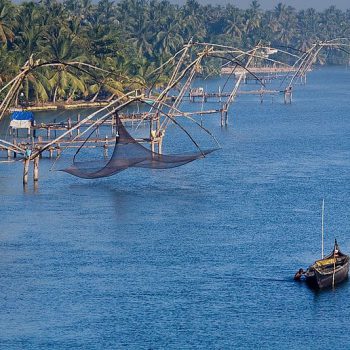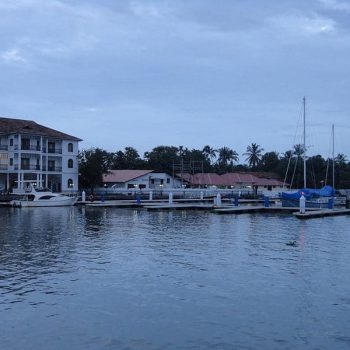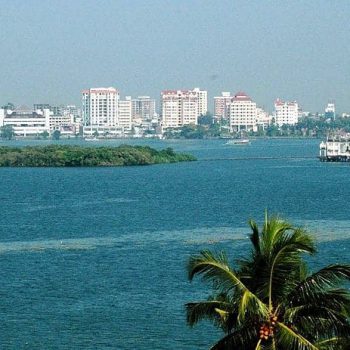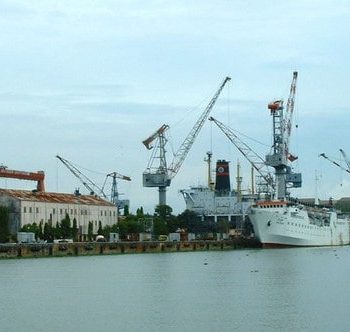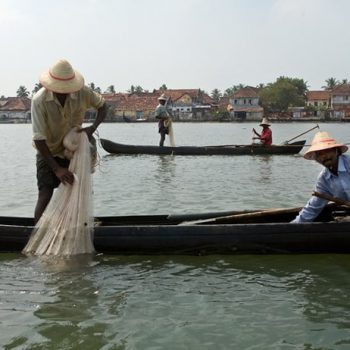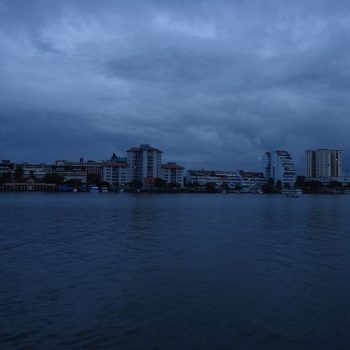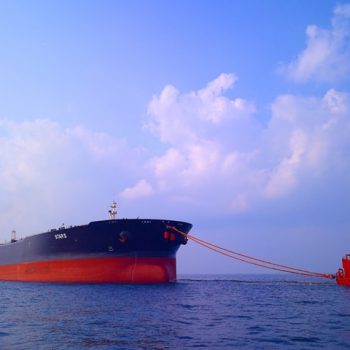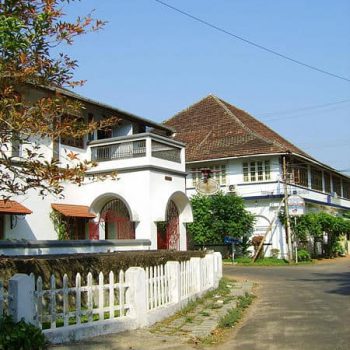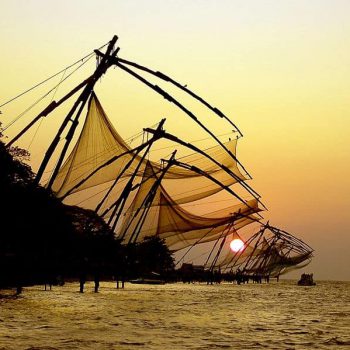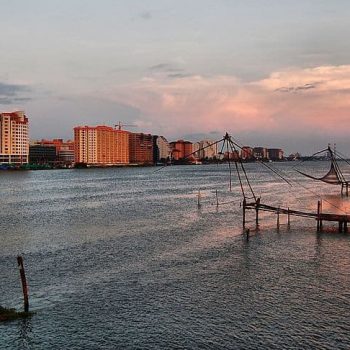Kochi (colonial name Cochin) is a vibrant city situated on the south-west coast of the Indian peninsula in the breathtakingly scenic and prosperous state of Kerala, hailed as 'God's Own Country'. Its strategic importance over the centuries is underlined by the sobriquet Queen of the Arabian Sea. Informally, Cochin is also referred to as the Gateway to Kerala.
From time immemorial, the Arabs, British, Chinese, Dutch, and Portuguese have left indelible marks on the history and development of Cochin. Over the years, Cochin has emerged as the commercial and industrial capital of Kerala and is perhaps the second most important city on the west coast of India (after Mumbai/Bombay). Cochin is proud of its world-class port and international airport that link it to many major cities worldwide.
Popularly known as the Queen of the Arabian Sea, Cochin (Kochi) is one of the finest natural harbors in the world and is the gateway to the enchanting backwaters of Kerala. Kochi is the business capital of Kerala and is one of the fastest-growing cities in India. It is comprised of a group of islands scattered along Vembanad Lake. An interesting ensemble of various cultures like the Portuguese, Jewish, English, French, Dutch, and Chinese, Kochi is a tapestry of vivid and varied colors, which attracts scores of tourists from far and wide to its shores.
The most important activity in any Cochin tourist itinerary would be a ferry ride across the vast expanses of Kochi backwaters. Hemmed with swaying coconut palms and Chinese nets silhouetted against the backdrop of the setting sun, the backwaters make a breathtaking spectacle. The majestic houseboats that glide across the water form another dramatic spectacle that not many cities in India can boast of. Cochin backwaters indeed occupy a top slot in the
Top Attractions
The Fort Cochin Heritage zone
This part of Cochin is frozen in time and takes you to the rich colonial heritage of Kerala. There are innumerable heritage buildings here some dating back to the times of Vasco Da Gama, the first Portuguese sailor to India.
- St: Francis Church: This imposing church is a mute witness to the colonial power struggles in India from early 16th century to mid 20th century. The church built by the Portuguese in 1503 AD is the oldest European church in India. The Dutch captured Cochin in 1663 AD and the church was revamped and turned into their church. The Dutch did further renovations in 1779 AD and a slab stone on the front façade bears testimony to it. The Church came under the British in 1803 and continued to be in their possession till 1947. The church is now under the Church of South India (CSI) a conglomeration of protestant churches. The original tomb of Vasco Da Gama, whose mortals remains were taken back to Lisbon in 1524, is located inside the church. There are intricately carved stone sepulchers of Portuguese and Dutch nobles located on either sides of the church. A huge rope operated fan is still preserved in perfect condition. There is also a war memorial honoring the First World War heroes in front of the church.
- Santa Cruz Basilica: Near the St Francis church is the colossal Roman Catholic Basilica of Santa Cruz (Holy Cross). The Basilica built by the Portuguese, has an excellent gothic façade flanked by two majestic towers. The church was given the status of a Cathedral in 1558 by Pope Paul IV and subsequently the status of a Basilica in 1984 by Pope John Paul II. The present structure was built in 1905 with exquisite frescoes and murals by the famous Italian painter Br. Moschini S.J. There is a beautiful painting of the last supper on top of the main altar and 7 spectacularly done large canvas paintings on the passion of Christ on the ceiling. The artistic grandeur emanating from the Basilica is further aggrandized by its beautiful stained glass windows and intricate carvings on the walls.
- Indo-Portuguese Museum: This Christian heritage museum is located on the Cochin Bishop House premises. The museum has five galleries with an outstanding collection of treasures collected from various churches all over the historic diocese of Cochin, offering a glimpse of Cochin's Portuguese heritage.
- Fort Cochin Beach: This beautiful beach is an ideal spot to view the cantilever operated huge Chinese fishing nets. These fishing nets were brought here in 13th century by Chinese traders from the courts of the great emperor Kublai Khan. The remains of the oldest European fort in India- Fort Immanuel, built by the Portuguese, is scattered along the stretch of the beach. A walk along the beautiful esplanade along the beach offers a glimpse of Cochin's rich historic legacy. Vasco Da Gama square lies on the side of the esplanade with a couple of open air cafes and stalls selling fish.
- Dutch Cemetery: This cemetery of 1724, now maintained by St. Francis Church, has countless tombs of people of Dutch origin buried here. The cemetery which was lying in a dilapidated condition has been recently restored to its original state.
- Parade Ground: This is where the military parades and drills of colonial times were held. There are several historic buildings on all the sides of the ground. The VOC gate located near the ground is a large wooden gate built in 1740 AD by the Dutch East India Company. The heritage structures of Thakur House, David Hall, Bastion Bungalow, and Malabar House are just a stones throw away from Parade Ground.
- Maritime Museum: The Maritime Museum inside INS Dronacharya showcases the origin, history and evolution of Indian Navy. It has separate galleries dedicated to Kerala and Indian Maritime histories.
The Mattancherry heritage zone:
Mattancherry is the eastern side of the old Cochin town with Fort Cochin on the western side.
- Jewish Synagogue: This is the oldest synagogue in the Common Wealth countries. This orthodox synagogue was built by wealthy Jewish merchants in 1568 AD. It is believed that Jews first came to Kerala to trade in spices and ivory during King Solomon's reign. There were ancient Jewish settlements close to Cochin, further enriched by a wave of Jewish inflow fearing persecution in Europe. This synagogue known as the Paradesi synagogue was historically used by the "white Jews". This orthodox synagogue houses the sacred Torah scrolls written in goatskin and gold crowns gifted by various kings inside the carved red and gold tabernacle. The 18th century Chinese hand-painted blue and white tiles are a unique feature of the Synagogue. None of these exquisite 1100 porcelain tiles are identical. The brass-pulpit and exquisite Belgian and Italian Chandeliers add further to the aesthetic beauty of the Synagogue. The Synagogue also has Hebrew inscriptions dating back to the 14th century. The painting gallery at the entrance depicts the history of Jews in Kerala from the times of King Solomon.
- Mattancherry Palace: This palace was built by the Portuguese in 1555 and presented to the Rajah of Cochin as a gesture of goodwill. The palace was later renovated by the Dutch in 1663 and hence also known as the Dutch Palace. The palace built in traditional Kerala style, is a quadrangular two storied structure with an open courtyard in the middle. The courtyard houses a temple dedicated to goddess Pazhayannur Bhagavathi. This palace basking in medieval aura has some exquisite woodwork and beautiful frescoes done in natural colors. The Ramayana gallery has enchanting murals from 16th century depicting scenes from the epic Ramayana completely done in natural colors. There are also royal portraits, palanquins, royal costumes, colonial maps and weapons on display. The ceilings are a real treat to the eyes with exquisite woodcarvings. There are some exotic murals in the downstairs bedchamber.
- Kumbalangi Model Tourism Village: Set in an idyllic rural area with virgin natural splendor, the small fishing hamlet of Kumbalangi offers a perfect bucolic escapade. Kumbalangi village is at a distance of 16Kms from Mattancherry/Fort Cochin/Ernakulam areas. The first of its kind in India, it is the brainchild of Kerala Tourism and Department of Tourism, Government of India. The island of Kumbalangi is surrounded by the scenic Kallanjeri backwaters dotted by Chinese fishing nets, green paddy fields and dense mangrove forests. Tourists can get a glimpse of rural Kerala in all its astounding beauty here.
- Other places of interest in Mattanchery are the imposing Our Lady of Health Church, the historic Chapel of Coonan Cross, the Jewish Cemetery with tombstone carvings in Malayalam and Hebrew, and the 100 year old Dharmanath Jain temple.
Vypeen Island Zone:
The island of Vypeen is located at the point where the Vembanad Lake merges with the Arabian Sea, with Fort Cochin on the other side. There are boats and jhankar services to Vypeen from Fort Cochin, and Vypeen is now connected to mainland Ernakulam through bridges.
- Our Lady of Hope Church: Known as "Nossa Senhora Da Esperança", this church was built by the Portuguese in 1604 A.D. The original wooden altar and screen of St Francis church were moved to this church when the Dutch took possession of St Francis church. This imposing church was renovated recently as part of its fourth centenary celebrations.
- Bolgatty Palace: Located in the scenic Bolgatty Island, the first of the two islands in between Ernakulam and Vypeen, this palace was built by a wealthy Dutch trader in 1744 AD. This is one of the oldest Dutch palaces built outside Holland. The palace, carefully restored with meticulous care to its original grandeur, is now a heritage hotel with all modern amenities.
- The Vallarpadam Basilica: The magnificent gothic Basilica of Our lady of Ransom is one of the oldest churches built by the Portuguese missionaries in India. The church is located on the second island between Ernakulam and Vypeen. The Basilica is now a national shrine and a prominent pilgrim centre for Christians in South India. The church's history is intertwined with various prominent Hindu families throughout the ages. According to one legend Meenakshiamma, a noble Nair lady of Palliveetil family, and her son were miraculously rescued from the bottom of the backwaters after being drowned for three days, in the year 1752 AD.
- Cherai Beach: The beautiful golden beach of Cherai in the Island of Vypeen is at a distance of 30Kms from Ernakulam/Cochin. Cherai has a long stretch of clean shallow beach on one side and tranquil backwaters with coconut lagoons on the other. This picture perfect sun kissed beach is ideal for swimming, sunbathing and water sports.
- Chennamangalam Synagogue: The 17th century Chennamangalam Synagogue, built in the traditional Kerala architectural style, is located in Paravur at a small distance from Vypeen. The majestically carved tabernacle, patterned roof, and intricate woodwork in the Synagogue were recently restored to their original grandeur by the Kerala State Archeology Department. It has a Hebrew inscription dated 1269 AD on a tombstone located in the synagogue courtyard.
- Vypeenkotta Seminary & Paliam Palace: The ruins of Vypeenkotta seminary and the fort built in the 16th century by the Portuguese lies near the Chennamangalam Synagogue.
The Paliam Palace, once the abode of Paliath Achans; the Prime Ministers of the erstwhile kingdom of Cochin, is also nearby. There are historic documents, relics and artifacts from the erstwhile kingdom on display at the palace.
Other places of importance in and around Vypeen are the Ochanthuruth Light house, Puthuvype Beach, the imposing Cruz Milagris church in Ochanthuruth and a 13th century Syrian Catholic church in Chennamangalam.
Ernakulam Zone:
This is the new face of Cochin, a buzzing metropolis with dazzling urban charms. This area has a lot of shopping venues ideal to indulge in a shopping orgy.
- Marine Drive Promenade: This picturesque promenade with a spectacular view of the backwaters and the harbor is considered to be one of the most beautiful parts of the city and ideal to chill out. A part of it has been converted into a musical walkway with beautiful paving, landscaping and park benches. The beautiful Chinese Fishing Net Bridge and the Rainbow Bridge are located along the walkway. There are shopping malls, cafes and food joints present along the walkway.
- Park Avenue: This beautiful boulevard dotted with trees is often called the most beautiful green stretch of the city. A number of educational institutions are located along this stretch of road. The Subhash Park and Indira Priyadarshini Children's Park facing the harbor are also located along this road.
- Durbar Hall Art Gallery: This gallery housed in the Durbar Hall Palace of Cochin Kings, has art exhibitions organized regularly. The Kerala Lalitha Kala Academy is also located in the building. The beautifully landscaped ground adjacent to the gallery is a regular avenue for Cultural programs and an ideal spot to enjoy an evening stroll.
- Ernakulam Siva temple: This ancient temple is a perfect example of Kerala style of temple architecture, simple yet elegant. The origin of the temple is steeped in legends and can be traced to the great Indian epic Ramayana. The temple is located adjacent to Durbar Hall Art Gallery.
- Thrikkakara Vamanamurthy Temple: This ancient temple is dedicated to Thrikkakara Appan or Vamanamurthy who is Lord Vishnu in disguise. The temple is linked with the origins of "Onam", the national festival of Kerala. Inscriptions dating back to 10th and 13th centuries are found here.
- Museum of Kerala History: The museum located in Edapally at a distance of 10Km showcases the rich cultural legacy and glorious history of Kerala. The museum complex also houses the MNF Gallery of Paintings and Sculptures and also the center for Visual Arts. Light and sound shows are regularly held in the museum. There are around 200 authentic original works, a number of reproductions of world renowned paintings and reproductions of Indian Mural arts in the museum.
- Wellington Island: Located between Ernakulam and Fort Cochin, this is a manmade island created with the dredged earth, when the Cochin port was deepened. The island was created by Sir Robert Bristow, an engineer with the British East India Company. The island now houses the Cochin Port Trust, the harbor, the Cochin Harbor Terminus railway station and a small park.
- Mangala Vanam Mangrove Forest: This fragile ecosystem is located in the heart of the city right beside the High Court of Kerala. This forest often called the green lungs of the city is a safe breeding habitat for migratory birds and home to a large number of birds and insects.
- Kalady: This famous pilgrim center at a distance of 45Km from Ernakulam is the birthplace of Adi Shankaracharya, the great Indian philosopher. There are two renowned shrines located here.
- Kodanad: Kodanad, one of the largest elephant training centers in India, is located at a distance of 45Km from Ernakulam. Tourists can enjoy elephant rides and see wild elephants being tamed. There is also a small zoo housing weak animals.
- Bhootathankettu: This scenic dam on the Periyar River is located at a distance of 50Km from Ernakulam. This is a great spot for picnic and enjoying the scenic beautify of Kerala. There are boat rides available. The Salim Ali Bird Sanctuary is quite close to Bhootathankettu.
- Cheraman Juma Masjid: This mosque located in Kodungallur near Ernakulam is considered to be the oldest mosque in India and the second oldest mosque in the world to offer Jumu'ah prayers. This magnificent mosque built in 629 AD by Malik Ibn Dinar is constructed in the traditional Hindu temple architecture style of Kerala. The burning sanctuary lamp of this mosque is said to be more than a thousand years old. Legends link this historic mosque to the Chera King Cheraman Perumal who embraced Islam in the 7th century AD.
Trippunithura Zone:
The capital of Cochin was moved to Trippunithura from Mattancherry after the sprawling Kanaka Kunnu palace was constructed here. Trippunithura has a vast number of palaces, temples and historic buildings.
- Sri Poornathraeesha Temple: This magnificent temple is dedicated to Lord Vishnu, the family deity of the Cochin Royal family. The temple was almost completely ruined in the great fire of 1900, but was restored to its original magnificent glory by the Kings of Cochin. The temple is now famous for its festivals celebrated with much pomp and gaiety even after the royal patronage is gone.
- Hill Palace Museum: Perched on top of a hillock, this magnificent palace complex sprawls over 52 acres of gardens, parks and lawns. The palace complex constructed in 1845 has 49 imposing buildings, built in the traditional Kerala and Western fusion architectural styles. The official residence of the erstwhile Cochin Royal Family, it now houses the largest archeological museum in Kerala. There are scores of galleries with priceless artifacts displaying the glory of the Rajas and the history of Kerala. The Throne room displays the magnificent Throne and antique furniture of the Royal era. The jewellery gallery in the museum houses 197 items and the dazzling solid gold royal crown adorned with precious jewels. Galleries are categorized as Numismatic gallery, portrait gallery, weapon gallery, sculpture gallery, bronze and silver gallery, epigraphy gallery, porcelain gallery, chariot gallery, heritage gallery and wood carvings gallery. There is also a rare medicinal plant garden and a deer park located inside the palace premises.
- St. Georges Orthodox Syrian Cathedral: Karingachira St. Georges Church built in 722 AD is one of the oldest Syrian Orthodox churches in Kerala. This magnificent church is built in the traditional architectural style of Kerala. The church enjoyed patronage from the Cochin Royal family. There are inscriptions found inside the church dating to the 8th century.
- Chottanikkara Temple: This is one of the most popular pilgrim centers in Kerala. The temple is dedicated to the powerful goddess Sri Rajarajeshwari and is famous for exorcisms. The annual festival held here attracts scores of pilgrims.
Things To Do
There are innumerable options available to travelers in Cochin. Some of the popular ones are –
- Houseboat cruises: A houseboat is the best way to enjoy the labyrinthine of Kerala backwaters. Cochin, with abundant widening and narrowing canals and lakes is best experienced with a houseboat cruise. These backwaters have always supported a unique waterfront lifestyle for the people of Cochin. Tourists can experience this unique lifestyle by renting one of the large thatched-roofed house boats known as "Kettuvallams". These boats cater equally to the needs of a family of two or a group of over a dozen people. They usually come with a captain, a cook and a steward. Kettuvallams lazily move around the canals and lakes giving you the perfect sense of peace and tranquility.
- Ayurvedic Spas: The state of Kerala is synonymous with wellness. Acclaimed as the birthplace of Ayurveda, a trip to this fabulous land is never complete without a visit to one of those refreshing Ayurvedic spas. There are different sorts of treatments available guaranteed to rejuvenate your body and soul. Treat yourself and indulge in this amazingly refreshing Ayurvedic spa experience.
- Kathakali: The dance-drama of Kathakali is a temple art form re-enacting stories from the Hindu epics. The characters are attired in elaborate costumes with brightly painted faces. Catch a glimpse of this exotic dance-drama in one of the various centers located in and around the heritage areas of Fort Cochin- Mattanchery or Ernakulam.
- Beach & Water sports: Refresh yourself with a trip to one of those gorgeous palm fringed beaches of Cochin. Opportunities are abundant to get invigorated in these magnificent beaches. For the adventurous soul, the best way to enjoy the backwaters is by taking canoeing or water biking.
Local Festivals
Trippunithura Athamagosham: Atham heralds the beginning of the ten day long Onam celebrations held during the month of September. On the day of Atham the erstwhile Maharaja of Cochin used to take a colorful procession from his capital Trippunithura to the historic Lord Vamanamurty temple in Trikkakkara. This vibrant march symbolized the secular views held by the king, with the priest of Karningachira St George Syrian Orthodox church, Chembil Arayan and Nettor thangal accompanying the Rajah in this auspicious occasion. The present "Athagosham" is a colorful rally held in Trippunithura on the day of Atham commemorating the historic march of the Rajah. Traditional art forms, caparisoned elephants, decorated traditional umbrellas, colorful floats, folk dances and traditional music all add to the richness of this unique celebration.
Cochin Carnival: This carnival is held during the last week of December to welcome the New Year. This carnival is still celebrated with the same zeal and fervor as it had been in the Portuguese colonial era. The entire Fort Cochin area is lit up in the festive gaiety during this period. The highlight of the Carnival is the massive parade taken out on New Years Eve. The Carnival parade has caparisoned elephants, dancers, colorful floats, traditional music et cetera.
Trippunithura Poornathraeesha Temple festival: Vrischikolsavam, the main festival of the temple celebrated during the month of November-December, coincides with the peak tourist season in the state. On the fourth day of the 8 day long festival the deity is taken out along with 15 fully caparisoned tuskers and accompanied with traditional Pancharimelam music. The cultural fiesta held during the festive season includes Kathakali performances, Carnatic music recitals and many traditional temple art forms.
Ernakulam Siva temple Festival: Every year the temple festival is held with much fervor in the month of January. During the 8 day long festival, a cultural fiesta is held showcasing enthralling temple art forms at the adjoining Durbar Hall ground. On the seventh day of the festival the "Pakalpooram" is held, when the deity is taken out in a colorful procession with caparisoned elephants accompanied by the pulsating Panchavadyam music. The temple feast concludes with a magnificent fireworks display.
Shopping
The Jew street in Mattanchery has an array of shops that sell antiques, carved wooden artifacts, bronze sculptures, exotic jewellery, oriental carpets and furniture. Antiques from all over South India are brought to this exotic market. There are also shops that sell cotton fabrics, perfumes, leather goods and Indian spices around Mattanchery.
In M.G Road Ernakulam, "Kairali" run by the state government has a good collection of handicrafts and artifacts on the offer. "Surabhi" located in the nearby Durbar Hall Road managed by Kerala Handicrafts society is also good for handicrafts. The main shopping areas in Ernakulam area are located in the city arterial M.G Road, the Marine Drive and Broadway.
- Vibrant Kerala Summer Package – 06 days/05 nights
- Kerala Monsoon Honeymoon Package 5 days/4 nights
- Explore Kerala Tour Package – 08 days/07 nights
- Spectacular South India Package – 10 days/09 nights
- South India Hill Station and Backwater Packages – 12 days/11 nights
- Best Kerala Monsoon Package – 06 days/05 nights
- Marvelous Monsoon Kerala Tour Package – 12 Days/11 Nights
- Enchanting Kerala Luxury Package – 08 days/07 nights
- Special Kerala Package with 4 * Hotels – 05 days/04 nights
- Kerala Delight Summer Package – 09 days/08 nights
- Gems of South – 11 days/10 nights
- Kerala Tour Package – 7 Days/6 Nights
- Romantic Kerala Honeymoon Package – 06 days/05 nights
- Blissful Kerala Holiday Package – 06 days/05 nights
- Treasures of Kerala Luxury Package – 12 days/11 nights
- Kerala Delight Monsoon Package – 9 Days/8 Nights
- Kerala Summer Honeymoon package – 04 days/03 nights
- Essence of Kerala Super Luxury Package – 9 Days/8 Nights
- Kerala Delight Super Luxury Package – 8 Days/7 Nights
- Explore Kerala Luxury Package – 11 days/10 nights
- Vibrant Kerala Super Luxury Package – 10 Days/09 Nights
- Kerala Super Luxury Package – 12 Days/11 Nights
- Magical Kerala Luxury Package – 10 days/09 nights
Cochin is a seaside town just 10 degrees north of the equator. Hence, it is a moderately hot and humid place round the year. Heavy showers with thunder and lightning are experienced between June-September due to the southwest monsoon. The northwest monsoon brings light rainfall from October-December. December to February is comparatively cooler than the rest of the year. The average annual rainfall is about 350cm, most of which is contributed by the southwest monsoon. During the summer, March-June, the temperature hits a usual high of 35°C (95°F) while the mild winter high is 25°C (77°F). The temperature range is usually 20°C-35°C (68°F-95°F).
